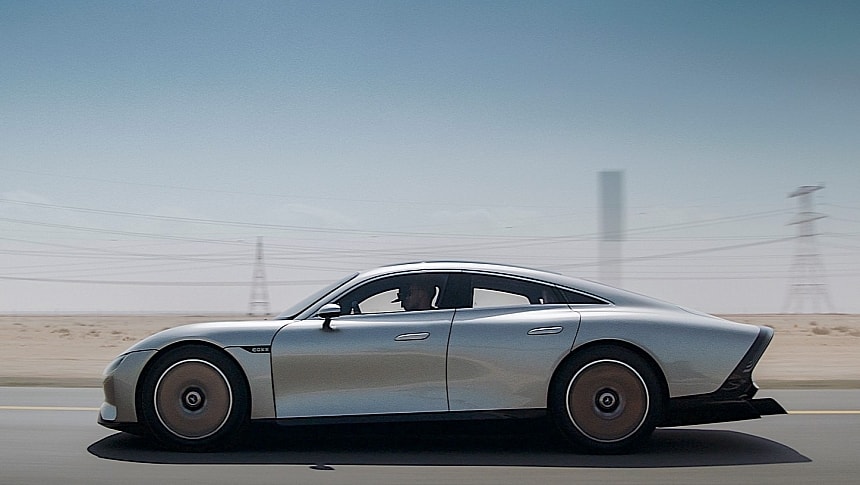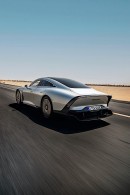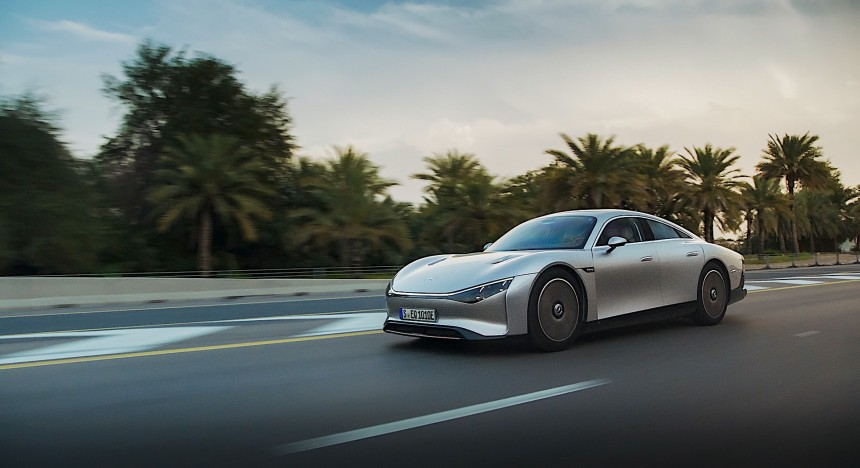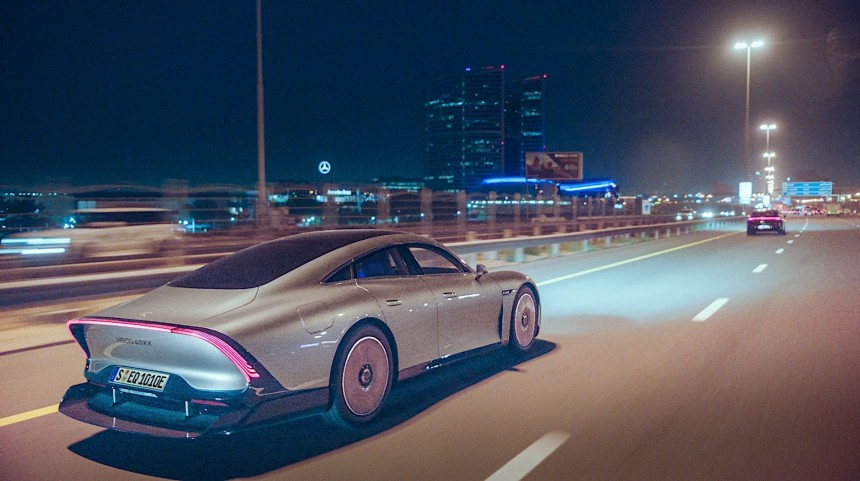A little more than two years ago German carmaker Mercedes-Benz pulled the wraps off a rather peculiar vehicle in its lineup. Called the Vision EQXX, it is meant to be a research vehicle into how effective electric cars can be.
When it unveiled the program in early 2022, the company stated no more, no less, that it targets a range of over 1,000 km (621 miles) with a single charge of the battery on this thing. That would be the Holy Grail all electric car makers are pursuing. And in the time that has passed since, Mercedes has done that not once, but three times, with the most recent such trip having been completed last week in the Middle East.
Key to those achievements are the technologies included in the car, but also its design. The car has been made in such a way as to achieve a drag coefficient of 0.17. Thanks to the use of digital tools and the use of 3D printed materials, it weighs only 1,750 kg (3,858 pounds).
And then comes its electric drivetrain. There is a 100 kWh, 900-volt battery on board, a system that comes with an energy consumption rating of 10 kWH per 100 km (62 miles) - and simple math will give you an answer about the car's hypothetical electric range.
On top of it all, Mercedes-Benz fitted solar cells on the roof of this thing. 117 of them are there to harness the power of the Sun and use it to power the vehicle's ancillary systems. The power it harnesses is also stored separately in a lightweight lithium-iron-phosphate battery that feeds the climate blower, lights, and infotainment system, among others.
The battery sends its juice to an electric motor that is capable of delivering 201 horsepower, and its range is not at all hypothetical. Until last week the Vision EQXX proved its worth and capabilities on long-distance trips between Sindelfingen and Cassis and later from Untertürkheim to Silverstone. And then it did it again, in a third successful trip of over 1,000 km.
This third time Mercedes decided to take the Vision EQXX in the desert, to put all of the above systems through their paces in an even more challenging environment. This time too the total distance traveled was huge - 1,010 km (627.6 miles) – and this time too the vehicle completed it with enough energy to spare left in the battery.
The EQXX set off from the Mercedes-Benz Center in Riyadh, Saudi Arabia, determined to go over a combination of city roads and desert highways with ease. The battery was, naturally, fully charged when it left.
The total distance the car covered before it reached its destination point, the Mercedes-Benz Brand Center in Dubai, the United Arab Emirates, was 1,010 km (627.6 miles). It completed it in 14 hours and 42 minutes without having to recharge its battery a single time.
More impressively than that, though, when it stopped in Dubai the EQXX still showed it could keep going at least 309 km (192 miles) more, because that's how much range was still left in the battery.
That would put the total capability of the battery system at 819 miles (1,318 km), which is a huge deal for the electric vehicle kin. But to be entirely fair, the car was not driven as we do our dailies, but with a lot more care.
The people behind the wheel took into account everything for their trip, including wind intensity and duration, adapting their speed to make full use of the existing conditions.
Separately, when stopped, the Vision EQXX was parked in such a way as to be aligned with the Sun and allow the solar panel roof to do its thing. Mercedes says the solar cells were able to capture 1.8 kWH of solar power, adding a total of 24 km (15 miles) to the range.
Mercedes revealed that the medium ambient temperature during the trip was 34 degrees Celsius (93 degrees Fahrenheit), and the air conditioning was on for the duration of the journey.
This third trip of the EQXX marked the moment when the EV "beat its own previous best by a considerable margin" in terms of efficiency. Mercedes recorded electric power consumption of 7.4 kWh for every 100 km of travel, which translates into the gasoline-powered car equivalent of 0.9 liters per 100 km, or 282 MPGe.
The car's third long-distance run was a means for Mercedes to "maximize efficiency in all areas and examine system performance under extreme desert conditions." The effects of the desert heat on the thermal management system were also under scrutiny.
Why is Mercedes-Benz doing all this? Well, some of the technologies included in the EQXX will be deployed on the production cars the Germans will build on the Mercedes-Benz Modular Architecture (MMA) platform. A preview of what to expect came at last year's Munich Motor Show, when the Concept CLA Class was shown.
Key to those achievements are the technologies included in the car, but also its design. The car has been made in such a way as to achieve a drag coefficient of 0.17. Thanks to the use of digital tools and the use of 3D printed materials, it weighs only 1,750 kg (3,858 pounds).
And then comes its electric drivetrain. There is a 100 kWh, 900-volt battery on board, a system that comes with an energy consumption rating of 10 kWH per 100 km (62 miles) - and simple math will give you an answer about the car's hypothetical electric range.
On top of it all, Mercedes-Benz fitted solar cells on the roof of this thing. 117 of them are there to harness the power of the Sun and use it to power the vehicle's ancillary systems. The power it harnesses is also stored separately in a lightweight lithium-iron-phosphate battery that feeds the climate blower, lights, and infotainment system, among others.
The battery sends its juice to an electric motor that is capable of delivering 201 horsepower, and its range is not at all hypothetical. Until last week the Vision EQXX proved its worth and capabilities on long-distance trips between Sindelfingen and Cassis and later from Untertürkheim to Silverstone. And then it did it again, in a third successful trip of over 1,000 km.
The EQXX set off from the Mercedes-Benz Center in Riyadh, Saudi Arabia, determined to go over a combination of city roads and desert highways with ease. The battery was, naturally, fully charged when it left.
The total distance the car covered before it reached its destination point, the Mercedes-Benz Brand Center in Dubai, the United Arab Emirates, was 1,010 km (627.6 miles). It completed it in 14 hours and 42 minutes without having to recharge its battery a single time.
More impressively than that, though, when it stopped in Dubai the EQXX still showed it could keep going at least 309 km (192 miles) more, because that's how much range was still left in the battery.
That would put the total capability of the battery system at 819 miles (1,318 km), which is a huge deal for the electric vehicle kin. But to be entirely fair, the car was not driven as we do our dailies, but with a lot more care.
The people behind the wheel took into account everything for their trip, including wind intensity and duration, adapting their speed to make full use of the existing conditions.
Mercedes revealed that the medium ambient temperature during the trip was 34 degrees Celsius (93 degrees Fahrenheit), and the air conditioning was on for the duration of the journey.
This third trip of the EQXX marked the moment when the EV "beat its own previous best by a considerable margin" in terms of efficiency. Mercedes recorded electric power consumption of 7.4 kWh for every 100 km of travel, which translates into the gasoline-powered car equivalent of 0.9 liters per 100 km, or 282 MPGe.
The car's third long-distance run was a means for Mercedes to "maximize efficiency in all areas and examine system performance under extreme desert conditions." The effects of the desert heat on the thermal management system were also under scrutiny.
Why is Mercedes-Benz doing all this? Well, some of the technologies included in the EQXX will be deployed on the production cars the Germans will build on the Mercedes-Benz Modular Architecture (MMA) platform. A preview of what to expect came at last year's Munich Motor Show, when the Concept CLA Class was shown.









